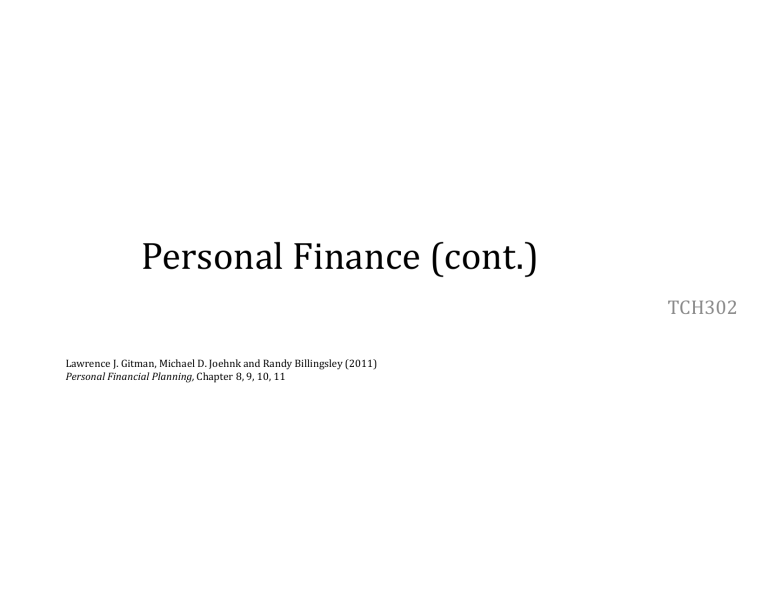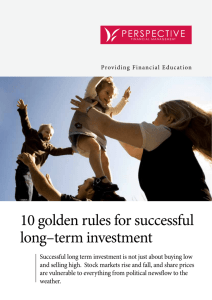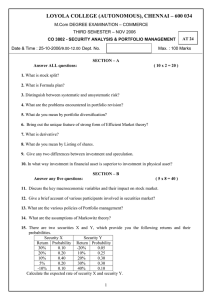
Personal Finance (cont.) TCH302 Lawrence J. Gitman, Michael D. Joehnk and Randy Billingsley (2011) Personal Financial Planning, Chapter 8, 9, 10, 11 Learning objectives Apply financial concepts in … o Managing personal assets/ Allocation assets and investment o Exploiting and managing personal insurance o Declaring and managing personal income taxes Personal finance planning Personal finance planning process 1. Define financial goals. 2. Develop financial plans and strategies to achieve goals. 3. Implement financial plans and strategies. 4. Periodically develop and implement budgets to monitor and control process toward goals. 5. Use financial statement to evaluate results of plans and budgets, taking corrective action as required. 6. Redefine goals and revise plans and strategies as personal circumstances change. Allocation assets and investment • Investment choices include exposure to the major and alternative asset classes • Risk and return trade-offs are inherent in all investment analysis • In order to build a portfolio of investments the investor must have appreciation of risk and return attributes • The main investment classes are: Cash Fixed Interest Shares Property Investor Attributes • Investors are classified into various groups based on: • Tolerance to risk • Preference for income versus capital growth • Investment timeframe • Defensive investors are more risk averse and are focused on preserving capital • Aggressive investors have more tolerance towards risk and focus on capital growth • Financial planners use these classifications to determine the appropriate asset mix for their clients Risk Profile o o o o o A person’s age Income Wealth Years to retirement Past financial experiences General Investor Attributes – By Classification Considering diversification • Returns on various assets are impacted by the broader economic environment in different ways • Diversification is owning/investing in more than one particular asset, and more than one asset class. • The goal of diversification is to minimise risk Illustrating how diversification can reduce risk in a portfolio of shares • For a portfolio of shares, we must consider the risk and returns of the whole portfolio rather than just the return of the individual shares in the portfolio • Portfolio risk is not simply a weighted average of the standard deviations of individual shares in a portfolio • It is necessary to understand the concept of correlation between the returns on shares • Correlation is the relationship between the return on one share compared to the other share • The correlation coefficient shows the extent of correlation among shares Illustrating how diversification can reduce risk in a portfolio of shares • The correlation coefficient shows the extent of correlation among shares • It has a numerical value of –1 to +1 which indicates the extent of risk reduction within a portfolio: Negative correlation (–1) -> Large risk reduction Positive correlation (+1) -> No risk reduction Diversification Across Asset Classes Investment strategy • General Investment Strategies: Gibson (2000)* argued that holding four asset classes in a portfolio (multiple-asset class investing) would reduce the risk of the portfolio and increase its average return. • This happens because the four asset classes are not strongly related to each other: • As one asset class performs well the others are less likely to perform as well and as the better performing asset class reverses its performance the other asset classes tend to perform better. • The performances tend to counteract each other which provides for a better long term average return and lower level of risk of such a portfolio. * Gibson, R. C. (2004). The rewards of multiple-asset-class investing. Journal of Financial Planning, 17(7), 58. Investor behaviour • The traditional view is that markets are efficient and that investors are rational. • Some irrational behaviour observed: • Loss aversion — prospect theory: investors dislike losses a lot more than they like equal gains. • Herding — people tend to follow crowd behaviour. • Overconfidence — many investors mistakenly believe they can beat the market resulting in overtrading and more losses. • Biased judgements — ‘house prices never go down’.* * Beaudry, P., & Willems, T. (2022). On the macroeconomic consequences of over-optimism. American Economic Journal: Macroeconomics, 14(1), 38-59. Information Sources for Investment Choices • • • • • • • Economic fundamentals Industry characteristics and reports Company background, prospects, annual reports Current market prices Government reports Analyst reports Using the internet as a search engine Risk and risk management Risk can be classified in a number of ways. One classification is speculative vs. pure risk Speculative risk arises where there is a chance of a loss or a gain (eg. gambling or starting up a business) Pure risk arises where there is only a possibility of loss or no loss (ie. no chance of gain) Can be personal, related to property, or as a result of liability The risk management process is a systematic approach to the identification and management of pure risks faced by individuals Key stages in the process are: Identification and evaluation of potential risks Possible losses and their costs Management of identified risks Avoidance and minimisation Program review To ensure ongoing protection Insurance is the principal means of providing for serious losses Insurance • Insurance is based on the concept of pooling • Pooling is where individuals contribute resources to a fund that is used to pay for the adverse consequences suffered by some members of the pool • The contribution to the pool is referred to as a premium • There are three main categories of insurance Life General • E.g. car, house, travel, business, indemnity, mortgage, workers’ compensation Health • Hospital cover or general (ancillary or ‘extras’) Risk management •Key stages in the process are: Identification and evaluation of potential risks Possible losses and their costs Management of identified risks Avoidance and minimisation Program review To ensure ongoing protection Need to consider the threats and vulnerability to these threats Threats could be related to health e.g. premature death, illness, injury It could be related to property e.g. loss of home, car, contents It could work related e.g. liability, business partner’s health What is the likely financial consequences from the identified risks?? Loss of income Costs that will be incurred Replacement cost When the potential loss is large, insurance may be the only option When the potential loss is small there may be other treatments available Identification and evaluation of potential risks- Life insurance • Financial consequences of death • • • • • • Funeral and associated expenses Medical expenses Mortgages Other debts Emergency funds Taxes and/or legal costs Who would be affected? Those who are financially dependent Degree of dependency Single income Two incomes Needs of dependants Young adults Young families Mature family Calculation of Insured Needs Risk management •Key stages in the process are: Identification and evaluation of potential risks Possible losses and their costs Management of identified risks Avoidance and minimisation Program review To ensure ongoing protection Risk avoidance: Avoiding an act that would create a risk. Loss prevention: Any activity that reduces the probability that a loss will occur Loss control: Any activity that lessens the severity of loss once it occurs. Risk assumption: The choice to accept and bear the risk of loss. => an effective way to handle many types of potentially small exposures to loss when insurance would be too expensive. Transfer – passing financial responsibility to another party by using insurance Life insurance Provides cover against the risks of premature death Named beneficiary receives the proceeds and is safeguarded from the financial impact of the death Who would be affected by the client’s death? To what financial extent would they be affected? What would be the appropriate insurance cover? E.g. Motor Vehicle and Risk management •Key stages in the process are: Identification and evaluation of potential risks Possible losses and their costs Management of identified risks Avoidance and minimisation Program review To ensure ongoing protection Damage to the vehicle itself Loss or damage to third parties or their property Control via car alarms, safety devices, etc. Financing through insurance Motor Vehicle Insurance • Compulsory third party (CTP) – covers legal liability for bodily injury to third parties arising out of the use of a motor vehicle • Full comprehensive insurance – covers damage to the vehicle itself, as well as damage to third party’s property • Fire, theft and third party property– covers third party property damage plus limited coverage of insured vehicle for fire and theft only • Third party property – only covers damage to third party property Declaring and managing personal income taxes In Vietnam: Law on personal income tax, 2007 Amending and supplementing a number of articles of the law on personal income tax, 2012 List of relevant regulations Personal Income Tax





